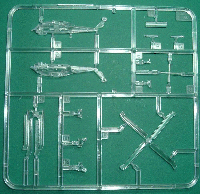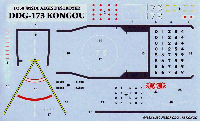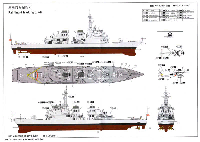JMSDF Kongo DDG-173

Reviewed by Sean Hert

| HISTORY | |||||||||||||||||
|
The JMSDF Kongo class guided missile destroyers are the Japanese version of the US Navy's Arleigh Burke class, Flight I. While sporting the same SPY-1D AEGIS radar and similar external features, the Kongo has a different internal arrangement, to better serve the requirements of the JMSDF, i.e. squadron flagship duties, etc, as well as being longer, beamier and displacing more. The Kongo has a 127mm OTO-Melara gun forward, differing from the Mk45 gun of the Burkes. The OTO-Melara has a higher rate of fire and an independent fire control system. The Mk41 VLS (Vertical Launch System) is equipped with the RIM-66 SM-2MR Standard missile and the RUM-136 ASROC, no BCM-109 Tomahawk cruise missiles are fitted, keeping with the defensive only nature of these ships. The Kongos are also armed with 2 quad RGM-84 Harpoon launchers, and 2 triple torpedo launchers. Like the Flight 1 Arleigh Burkes, there is a helicopter landing pad only; no provisions for a hangar or other support facilities. The 1/350 JMSDF Kongo DDG-173 marks one more entry from Trumpeter in releasing kits of the world's modern navies. Trumpeter had released ships from the United States Navy, Russian/Soviet navies, and the People's Liberation Army Navy of China; this makes a first for the Japanese Marine Self-Defense Forces. |
|||||||||||||||||
| HULL PARTS | |||||||||||||||||
|
Kongo's hull is molded in Trumpeter's standard 2-piece hull; grey upper hull, red plastic lower, with an red hull plate for the waterline option. All the parts fit well together, with little or no seam. The upper hull is clean, with no bad mold lines, flash or other defects. There are symmetrical hull plating welds on the upper hull. These are somewhat heavy; the modeller will probably want to sand these down. At first glance, the hull does seem to have the appropriate shape for Kongo, including the distinctive sweep of the bows. The lower hull leaves the difficult to mold bow sonar as a separate pepieceo be added later. The lower hull does exhibit some heavy mold marks, as is usual with Trumpeter offerings. The hull is a bit out of spec; Wikipedia has Kongo's dimensions as 161m x 21m x 6.2m, or 46cm x 6cm x 1.77cm. My measurements show Trumpeter's hull to be 46.6cm x 5.8cm x 1.83 cm. |
|||||||||||||||||
 |
|||||||||||||||||
|
|||||||||||||||||
| DECK PARTS | |||||||||||||||||
|
The deck comes as a single piece, slightly angled in the stern for the slight dip in the hull. The fore and aft sections have the most detail, fitting for a modern warships. The deck details are somewhat unadorned; i.e. the VLS doors should have a rough, non-skid texture. I do not care for the raised areas for decal placement. |
|||||||||||||||||
|
|||||||||||||||||
| SPRUE A | |||||||||||||||||
|
Sprue A has the shafts, screws, rudders/stabilizers, sonar dome and stand. The sonar dome presents with some slight flash, but the seam on a 2 piece part like this will usually require sanding anyway. The scimitar shaped blades on the prpropellersre very clean and crisp, and look good. |
|||||||||||||||||
 |
|||||||||||||||||
|
|||||||||||||||||
| SPRUES B | |||||||||||||||||
|
Sprue B consists of the main parts for the forward superstructure and bridge. There are some nice details molded on these parts; however the AN/SPY-1D antennas look a bit undersized, and have the incorrect number of fasteners around the edge. |
|||||||||||||||||
 |
|||||||||||||||||
|
|||||||||||||||||
| SPRUES C | |||||||||||||||||
|
More superstructure parts, and the exhaust stack for the gas turbine engines. |
|||||||||||||||||
 |
|
||||||||||||||||
| SPRUES D | |||||||||||||||||
|
Sprue D is much like C, with parts for the aft superstructure and stack. |
|||||||||||||||||
 |
|||||||||||||||||
|
|||||||||||||||||
| SPRUE E | |||||||||||||||||
|
This sprue is loaded with different parts; the main turret, parts for the mast, ladders, anchors and other details. The main turret is disappointing, with a large mismatched mold line leaving a considerable seam around the gun house. |
|||||||||||||||||
 |
|||||||||||||||||
|
|||||||||||||||||
| SPRUE F x2 | |||||||||||||||||
|
Sprue F compliments sprue E with additional weapons and deck details. The Phalanx CIWS, Harpoon cacanistersnd torpedo launchers are present, as well as a number of chaff launchers and communication antenna. |
|||||||||||||||||
 |
|||||||||||||||||
|
|||||||||||||||||
| SH-60J | |||||||||||||||||
|
The SH-60J, a license-built variant hybrid of the SH-60B and SH-60F, is the current standard helo for the JMSDF. Molded in clear plastic as Trumpeter does with most aircraft now, the helo is done well. However, it is missing the observation bubble in the side of the fuselage of the few distinctive external differences of this aircraft. |
|||||||||||||||||
 |
|||||||||||||||||
|
|||||||||||||||||
| DECAL | |||||||||||||||||
|
A large decal sheet is included, with only markings for Kongo; spelled "Kongou" on the decal for the baseplate. There are some large one-piece decals for the flight deck markings. These may prove a little challenging for some modellers; on the other hand, Trumpeter did mold raised areas for these decals on the deck, which should aid novice builders. |
 |
||||||||||||||||
| INSTRUCTIONS | |||||||||||||||||
|
A 16 page instruction book is included, using Trumpeter's standard construction order and methods. A full color poster showing the painting steps is included, with Gunze colors referenced. |
 |
||||||||||||||||
|
|||||||||||||||||
| CONCLUSIONS | |||||||||||||||||

It is fun and interesting to see Trumpeter releasing models of some ships from other than the USN and Russian navies. The growing number of modern subjects in 1/350 indicates this is a great time for those modelers who enjoy modern subjects! The main detraction of this kit is its very high cost. Thanks to Stevens International for the review sample. It is listed as #TSM-4532 1/350 Kongo DDG173 Japanese Destroyer with a retail price of $84.95 US. Stevens is the exclusive importer for Trumpeter kits in the US. If your hobby shop does not carry Trumpeter kits have them contact Stevens International or try their Hobby Shop Locator to find one that does. |
|||||||||||||||||
